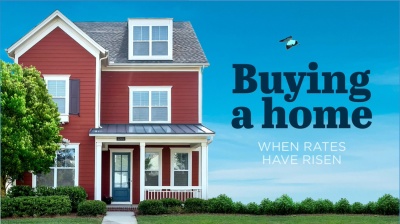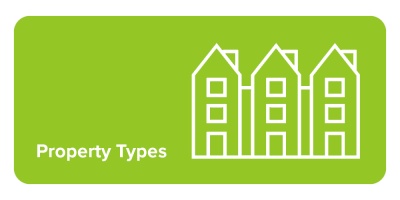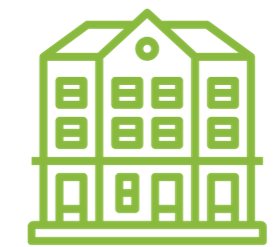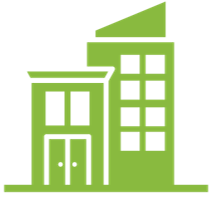
It's true rising interest rates can make a big difference in your monthly mortgage payment. But interest rates are only one factor in the cost of financing a home. The market changes that typically come with rising rates can be beneficial and even help mitigate higher payments.
Low-Rate Environment vs. Average Rate Environment
Low-Rate Environment
In a low-rate environment, buyers are likely to rush to the market. That creates stiff competition, which can lead to a frenzy of bidding wars and rapidly rising prices.
Average Rate Environment
In a calmer environment, you’re less likely to compete against other buyers. You’re more likely to:
-
Have time to see and compare homes.
-
Negotiate on price.
-
Receive seller concessions, such as a credit towards closing costs or funds to reduce your rate.
-
Enjoy the safety of important contingencies like home inspections and mortgage financing.
-
Avoid making a rash decision you may regret later.

In fact, a lower price at a higher rate can be comparable to paying an inflated price at a lower rate. In other words, the real cost of a home today may be no different than it was when rates were lower, but competition was fierce and prices were at a premium.

If you’re comfortable making the payment you secure today, you can have peace of mind knowing your monthly cost will be even easier to make if you’re income rises. And if rates fall, refinancing can help you save even more.
History shows there’s one thing that rates don’t change about the housing market. It’s proven true whether mortgage rates were at their peak, at historic lows, or hovering around their average. Home values tend to rise over time.
We can’t predict the future as populations increase and the amount of buildable land stays the same, it’s likely values will keep going up over time. And when home values rise, homeowners gain equity and build wealth.
Bottom Line:
If you’re considering a move, don’t let rates hold you back. You may be surprised at the tools we have to help you reach your goals, no matter the market. A pre-approval at today’s rate is a great place to start. Reach out when you’re ready.

When it’s time to buy a new home, it helps to know not only where you want to live, but also what type of home you’ll choose.
From single family homes to condos and townhouses, each property type has unique characteristics to understand before you buy.
Below you’ll find the differences between seven common property types. After reading through each you’ll have a better idea of which one best suits your lifestyle and needs.
Let’s start with Single family homes.
Single Family:
A single-family home, or stand-alone house, is the most common and popular type of home. Some single-family homes are in subdivisions or communities that fall under the governance of a homeowner’s association (HOA). If applicable, buyers should become familiar with the HOA's rules and covenants prior to deciding to purchase.
Ownership is by deed, and you own the land, the dwelling, additional structures, and any improvements made to them.
Multi-Family:
Multi-family housing can refer to anything from a two-family home up to an apartment building with hundreds of units.
Ownership is by deed. Typically, one owner will hold the deed for the land, all units, and any additional structures, common areas and amenities. The owner will often occupy one unit and lease the remaining units to renters. Conventional residential financing is available only on properties up to 4 units. Additional units typically require commercial financing.
Condo:
Condominiums, or condos, can take many forms but are typically residential living units like apartments.
Ownership is by deed. Rather than owning a building and the land, you own only your unit and a percentage of the common areas like hallways, the grounds, and amenities.
P.s. If you’re buying for the first time, condos make a great first choice!
Co-Op: 
Co-ops (cooperatives) are similar to condos in that they are usually like an apartment unit. More rarely, there are versions more like single family homes.
However, the ownership is unique. Rather than having a deed, you own shares appropriated to an individual unit, including an interest in the common areas and amenities.
Townhouse:
A townhouse is one unit in a series of attached city rowhouses where dividing walls can be shared. The term can also refer to the style of home rather than to the type of ownership. The style is often part of a condominium community.
Ownership of a true townhome property type is by deed, which will describe the exact bounds or dividing lines and land owned. The experience will typically be similar to owning a single-family residence.
Townhouses are another great option for first-time buyers!
Land:
Land, often called a lot in residential areas, is property with no structures. Land is easier to finance when you plan to use a construction loan to build a home on it.
Ownership is by deed. Many residential lots are in subdivisions that have a homeowner’s association (HOA). If applicable, buyers should become familiar with the HOA's rules and covenants prior to deciding to purchase.
Commercial: 
Commercial properties are designated for business uses, including retail, services, offices, etc. Financing is different than for residential properties.
Ownership is typically by deed, but commercial properties can also be part of a condo association.
Bottom Line:
If you have questions about properties or any aspect of home financing, please reach out. The Greenway Team is here and ready to help!

The Annual Percentage Rate (APR) is not the rate you pay. Homebuyers will often believe the lowest annual percentage rate (APR) is the best.
In fact, it's more important for buyers to weigh options against their personal financial situation and the amount of time they plan to have the loan.
Low APRs typically come with the highest cost, and those funds can often be better deployed against larger down payments or, in some instances, paying off high-rate consumer debt.
Here's a quick overview of what an APR is and how to calculate the costs and/or savings that accompany a lower one.(1).png)
What is APR?
APR is not the interest rate that you pay. It’s a government-required calculation intended to show the total cost of borrowing, expressed as an interest rate.
The APR is derived from a formula using these two factors:
- The actual rate and term of your loan
- Certain closing costs that are associated with your loan
Again, it is not the rate you actually pay. Click here to see how APR actually works.
APR is best used as a tool for comparing loans with dissimilar terms. Where APR is lower, associated costs of closing your loan may actually be higher. Keep in mind that the calculation assumes you'll keep your loan for its full term. Few people ever see the 5th year of their home loans these days, much less the 30th.
APR will be lower on a loan where you pay more “points” to lower the interest rate. But if you don’t hold the loan long enough to earn back the points paid up front, that money will be wasted. If APR were calculated for the average amount of time borrowers actually have their loans instead of the full term, it would be higher. Comparisons would be more helpful and less potentially misleading.
Bottom Line:
APR is intended to give you more information about what you're really paying.
Any time you or someone you know has questions about interest rates or any aspect of home financing, please reach out.
The Greenway Team is happy to help! Reach out to us today.

Is the home you want out of reach?
In a time of rising rates and prices, the home you really want may be out of reach with the typical fixed-rate loan.
But stretching further isn't really much of a stretch at all with an ARM—an adjustable rate mortgage. If you're skeptical, be assured they've changed for the better over the years.
Here's How Adjustable Rate Mortgages Work:
-
Most ARMs are hybrid. They are fixed for a period of time, usually 5, 7 or 10 years, before being subject to adjustments.
-
During the initial period, rates (and monthly payments) will typically be lower than those offered by fixed-rate loans.
-
Interest rate caps can keep future adjustments predictable.
For example, a 30-year loan of $300,000 could have a payment savings of over $183 per month with an interest rate that's 1% lower. A loan such as a 5/1 ARM may offer this kind of payment savings.
Is An ARM Right For You?
ARMs aren't for everyone, but hybrid ARM loans can offer years of fixed principal and interest payments. They work especially well if you plan to sell or refinance before the adjustments occur.
Click below to estimate the payment and savings a hybrid ARM can offer, as well as income required to qualify.
If higher rates and prices are keeping you from the home you really want, it is worth a look to see the difference an ARM loan may provide.
Please reach out, and we'll be happy to help.
Private Mortgage Insurance What Is It and When Can You Cancel PMI?

If you’ve purchased your home with a down payment lower than 20% of the purchase price, you’re likely paying each month for private mortgage insurance (PMI).
We’ve got all the details on PMI, why you need it, how it’s paid, when you can cancel, and more.
What Exactly is Private Mortgage Insurance?
Private Mortgage Insurance, also called PMI, is a type of insurance you may be required to pay for if you have a conventional loan. PMI protects the lender if you stop making payments on the mortgage loan.
PMI is not to be confused with Homeowner’s Insurance, which is required and protects the physical home and property.
When is Private Mortgage Insurance Required?
PMI is required when a borrower has a conventional loan and makes a down payment of less than 20 percent on the price of the home, they are buying. However, if a borrower puts down more than 20 percent, PMI is not required.
Take into consideration the same thing for a home refinance. If you refinance with a conventional loan and your equity is less than 20 percent of the value of the home, PMI is usually required. Speak with your lender for more information.
How Do You Pay for Private Mortgage Insurance?
In most cases, mortgage lenders will roll PMI into your monthly mortgage payment as a monthly premium. Other times, PMI can be paid for as a one-time up-front premium which is paid at closing. Your loan estimate and closing disclosure documents will specify the amount of your Private Mortgage Insurance.
When Can You Cancel PMI?
The good news is that you will not have to pay private mortgage insurance forever. It can be canceled once your loan-to-value (LTV) falls below 80 percent of the home’s original appraised value. Sometimes this can happen sooner if your home’s value appreciates before then.
How Do I Cancel My PMI?
As we noted above, you may be eligible to cancel your PRMI when your equity reaches 20 percent. Your Private Mortgage Insurance will fall off automatically once you reach 22 percent equity. However, if you’re at 80 percent equity, want to be proactive, and save some money, you can reach out to your mortgage lender and request that they cancel your PMI. Your lender will advise on the necessary steps to take to cancel PMI.
If you’re not quite at 80 percent equity in your home, continue to make your mortgage payments on time each month.
Mortgage Tip: Have extra cash for a month? If so, put that money toward your principal to build your equity even faster. Be sure to make a note to your lender that you want the extra payment to go towards your principal balance and not your next mortgage payment. This can easily get confused or overlooked otherwise.
Is The Time Up on Your PMI? It’s Time to Find Out!
Use our PMI Removal Calculator to find out if you’re eligible to drop PMI and, if not, how much further you may need to go before you get to that point.
If you have any questions along the way about canceling PMI or home financing in general, please reach out. We are happy to help.


.png)



.png)

.png)